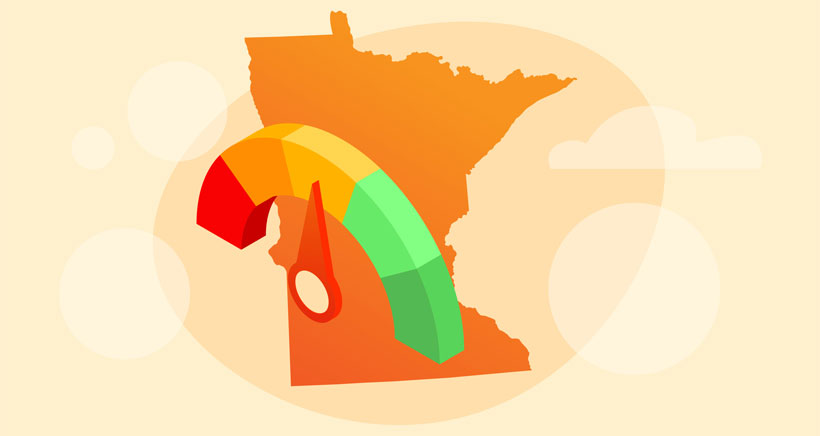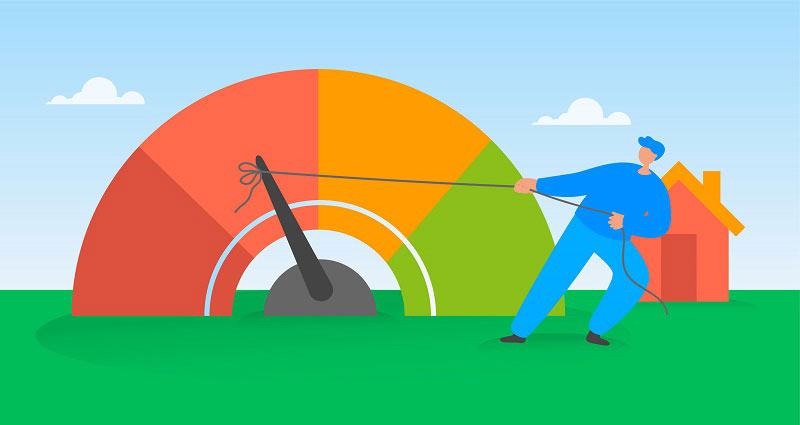
The average Vantage Score in Minnesota is 720. The “Land of 10,000 Lakes” is a huge state, but more than half of its residents live in just two cities, Minneapolis and St. Paul. These two cities, which are literally right next to each other—it’s only a 17-minute drive from the center of Minneapolis to the center of St. Paul—constitute the center of business, transportation, and industry for the state.
Despite notoriously harsh winters, Minnesota boasts one of the highest standards of living in the country. Approximately 33 percent of the state’s residents have at least a bachelor's degree, the median household income is above $60,000, and only 11 percent live at or below the poverty level. [1] America's Most (and Least) Educated States https://247wallst.com/special-report/2014/09/23/americas-most-and-least-educated-states/2/
Despite these glowing statistics, Minnesota’s relationship with debt and credit is a complicated one. Minnesota’s above-average credit score belies other issues that make that statistic a bit deceptive. This article will take a closer look at Minnesota’s relationship with debt.
Key Statistics
- Minnesota’s average credit score is 720. The national average is 690.
- While many states have an average credit score over 700, none have ranked higher than 712.
- The total of mortgage delinquencies of 60 days or more almost tripled between 2019 and 2020, increasing 1.4 percent to 4.3 percent.
- Minnesota’s cost of living is 2.5 percent below the national average, so your dollar actually goes further there. A dollar in Minnesota is worth approximately $1.03, meaning you can buy a little more with it. [14] The Average Cost of Living by State, and Why Ignoring it Could Sink Your Business https://www.patriotsoftware.com/blog/accounting/average-cost-living-by-state/.
- Nationally, the delinquency rate for auto and retail loans is 4 percent. Minnesota’s is 2 percent. [15] What regions have more delinquent auto loan debt? https://www.urban.org/urban-wire/what-regions-have-more-delinquent-auto-loan-debt In Minnesota, 78 counties have a delinquency rate of less than 20 percent.
- Students attending Minnesota’s private colleges carry more student loan debt ($41,133 per student) than students attending public colleges ($33,873 per student).
Minnesota’s Credit Score Over Time
| Year | Average Vantage Score - MN |
|---|---|
| 2015 | 704 |
| 2016 | 752 |
| 2017 | 677 |
| 2018 | 713 |
| 2019 | 715 |
| 2020 | 720 |
Minnesota’s credit score is consistently above the national average, and is also the highest in the nation. [2] Minnesota residents have the highest average credit score—here’s how other states compare https://www.cnbc.com/select/average-credit-score-by-state/ This has been true every year since 2015, with one notable exception. In 2017, Minnesota’s average Vantage Score dipped below 700 to 677, just one point below the national average of 678, but then went immediately back up again the following year. Since 2018, the state has continued this trend. While the reasons for this aren’t exactly clear, one economic indicator that coincides with this dip is slower than average economic growth for the state from 2016 to 2017. [17] The bad news is Minnesota’s economy grew more slowly than the U.S. last year. That might also be the good news https://www.minnpost.com/economy/2018/07/bad-news-minnesota-s-economy-grew-more-slowly-us-last-year-might-also-be-good-news/

How to Build Credit When You Have None
Building credit from scratch can be a lot easier when you understand where to start and which mistakes to avoid.
Download our guideHow Credit Scores in Minnesota Compare to Other States
| Year | Average Vantage Score - MN | Average Vantage Score - US |
|---|---|---|
| 2015 | 704 | 672 |
| 2016 | 752 | 726 |
| 2017 | 677 | 678 |
| 2018 | 713 | 682 |
| 2019 | 715 | 684 |
| 2020 | 720 | 690 |
Minnesota’s Vantage Score has been consistently the highest in the country. While many states have a credit score above 700, none have gotten higher than 712. Minnesota’s Vantage Score is a full 8 points higher at 720. All of the states with a score above 700 fall into three geographical regions: Midwestern (Iowa - 707, Nebraska - 707, North Dakota - 709, Wisconsin - 711), New England (Vermont - 712, New Hampshire - 711, Massachusetts - 710, Connecticut - 700), and Western states (Washington - 710, Oregon - 705, Montana - 704, Idaho - 700, and Utah - 700).
Debt in Minnesota
| Year | Average Household Debt - MN | Average Household Debt - US |
|---|---|---|
| 2003 | 39,800 | 33,430 |
| 2004 | 44,220 | 37,290 |
| 2005 | 48,160 | 40,650 |
| 2006 | 52,030 | 45,410 |
| 2007 | 55,200 | 50,170 |
| 2008 | 55,930 | 52,010 |
| 2009 | 53,660 | 49,820 |
| 2010 | 50,840 | 47,410 |
| 2011 | 52,110 | 47,790 |
| 2012 | 51,310 | 47,020 |
| 2013 | 50,470 | 45,310 |
| 2014 | 50,660 | 45,710 |
| 2015 | 51,110 | 46,000 |
| 2016 | 51,850 | 46,950 |
| 2017 | 53,260 | 48,800 |
| 2018 | 54,190 | 50,090 |
| 2019 | 55,380 | 51,580 |
Household debt in Minnesota is consistently above the national average. As of 2019, Minnesota ranked 14th in average total household debt at $55,380 per household. Minnesota’s debt-to-income ratio is also around the middle of the pack at 1.41.
So how can a state bear consistently above-average debt, but maintain such a favorable credit score? While the level of debt in Minnesota remains above the average, the gap seems to be narrowing. In 2003, the difference between household debt in Minnesota and the national average was more than $6,000. In 2007, just before the recession, the difference was just over $5,000. In 2019, the difference is less than $4,000.
So what is the difference between pre-recession and post-recession Minnesota? Credit utilization offers a clue. [4] Experian 2020 Consumer Credit Review https://www.experian.com/blogs/ask-experian/consumer-credit-review/ Minnesotans seem to deal with hard economic times by tightening the belt a bit and paying down debt, which improves credit scores. The gap between Minnesota’s household debt and the national average was never narrower than during the recession that began in 2008. This also holds true during the current COVID-19 pandemic. 2020 was certainly a year of economic uncertainty which led to Americans spending less and making more on-time payments. [3] Amid COVID-19, Minnesota Residents Again Have Highest Average Credit Score https://www.usnews.com/news/best-states/articles/2021-01-07/minnesota-residents-again-have-highest-average-credit-score
Mortgage Debt
| Year | Average Mortgage Debt - MN | Average Mortgage Debt - US |
|---|---|---|
| 2003 | 29,530 | 23,740 |
| 2004 | 32,750 | 26,590 |
| 2005 | 35,710 | 29,230 |
| 2006 | 39,250 | 33,400 |
| 2007 | 41,880 | 37,250 |
| 2008 | 42,360 | 38,490 |
| 2009 | 40,650 | 36,810 |
| 2010 | 38,420 | 35,010 |
| 2011 | 38,100 | 34,200 |
| 2012 | 37,190 | 33,230 |
| 2013 | 36,250 | 31,630 |
| 2014 | 35,870 | 31,520 |
| 2015 | 35,900 | 31,330 |
| 2016 | 36,040 | 31,590 |
| 2017 | 36,950 | 32,940 |
| 2018 | 37,460 | 33,680 |
| 2019 | 38,510 | 34,790 |
One area that reveals a problem the state has been dealing with since before the recession is mortgage debt. You can see from the trend lines that while mortgage debt is higher than the national average, the trend follows the nation very closely. Besides having a higher-than-average level of debt, the state’s level of delinquencies of 60 days or more nearly tripled between the summer of 2019 and the summer of 2020, due to the COVID-19 pandemic. [5] Federal Reserve Bank of Minneapolis - Ninth District mortgage conditions stabilize over summer https://www.minneapolisfed.org/article/2020/ninth-district-mortgage-conditions-stabilize-over-summer The good news for many of these homeowners is that because the CARES Act and the Pandemic Unemployment Compensation program instituted the possibility of mortgage forebearances, the delinquency rate has at least stabilized. [6] Federal Reserve Bank of Minneapolis - Large income losses loom for many workers when Pandemic Unemployment Compensation expires https://www.minneapolisfed.org/article/2020/large-income-losses-loom-for-many-workers-when-pandemic-unemployment-compensation-expires
One of the major contributors to Minnesota’s high mortgage debt is above-average housing costs. While Minnesota’s total cost of living is below the national average, the state’s housing prices are almost 2 percent above the national average. The median cost of a home in Minnesota is $235,600, while the national average is $231,200. [8] Cost of Living in Minnesota https://www.bestplaces.net/cost_of_living/state/minnesota Housing prices have increased 4.8 percent from 2019 to 2020, rising for the eighth year in a row. [9] Minnesota home prices continue to go up despite pandemic https://www.kare11.com/article/news/investigations/minnesota-home-prices-continue-to-go-up-despite-pandemic/89-c3400997-061e-4fe9-bbb0-e6ac7b427fe4
Credit Card Debt
| Year | Average Credit Card Debt - MN | Average Credit Card Debt - US |
|---|---|---|
| 2003 | 2,800 | 2,960 |
| 2004 | 2,990 | 3,040 |
| 2005 | 3,200 | 3,060 |
| 2006 | 3,290 | 3,170 |
| 2007 | 3,610 | 3,490 |
| 2008 | 3,750 | 3,670 |
| 2009 | 3,500 | 3,370 |
| 2010 | 3,190 | 3,050 |
| 2011 | 3,090 | 2,950 |
| 2012 | 2,960 | 2,850 |
| 2013 | 2,870 | 2,710 |
| 2014 | 2,930 | 2,730 |
| 2015 | 2,970 | 2,800 |
| 2016 | 3,080 | 2,930 |
| 2017 | 3,200 | 3,100 |
| 2018 | 3,290 | 3,220 |
| 2019 | 3,380 | 3,390 |
Of all the indicators of Minnesota’s above-average credit score, the way Minnesotans handle credit cards contributes the most to that score. Like household and mortgage debt, Minnesota’s average amount of credit card debt is above the national average, but not by much. Between 2018 and 2019, it narrowed the gap to within $10.
One thing that certainly helps Minnesotans keep debt under control is a cost of living that is 2.5 percent below the national average. [7] Credit Card Debt In Minnesota: Average Score, Balance, More https://patch.com/minnesota/eagan/credit-card-debt-minnesota-average-score-balance-more Minnesota’s average costs for groceries, healthcare, utilities and transportation are all under the national average. [8] Cost of Living in Minnesota https://www.bestplaces.net/cost_of_living/state/minnesota Having more disposable income available means a reduction in late payments, which directly contributes to a good credit score.
Auto Loan Debt
| Year | Average Auto Loan Debt - MN | Average Auto Loan Debt - US |
|---|---|---|
| 2003 | 2,580 | 2,960 |
| 2004 | 2,560 | 3,040 |
| 2005 | 2,670 | 3,240 |
| 2006 | 2,650 | 3,360 |
| 2007 | 2,620 | 3,360 |
| 2008 | 2,540 | 3,310 |
| 2009 | 2,290 | 3,030 |
| 2010 | 2,250 | 2,950 |
| 2011 | 2,500 | 3,050 |
| 2012 | 2,700 | 3,270 |
| 2013 | 2,990 | 3,420 |
| 2014 | 3,260 | 3,720 |
| 2015 | 3,550 | 4,070 |
| 2016 | 3,690 | 4,340 |
| 2017 | 3,950 | 4,520 |
| 2018 | 4,130 | 4,700 |
| 2019 | 4,220 | 4,850 |
Auto loan debt in Minnesota has been significantly below the national average for years. The biggest factor contributing to this trend is the low cost to own an automobile. The average cost of gasoline, car insurance and maintenance expenses is about 96 percent of the national average. [8] Cost of Living in Minnesota https://www.bestplaces.net/cost_of_living/state/minnesota
Minnesotans also have a low delinquency rate for auto loans. Nationally, the delinquency rate for auto and retail loans is 4 percent. Minnesota’s is 2 percent. [15] What regions have more delinquent auto loan debt? https://www.urban.org/urban-wire/what-regions-have-more-delinquent-auto-loan-debt Minnesota is tied for this distinction with 11 other states (Maine, Massachusetts, Montana, Nebraska, New Hampshire, North Dakota, Oregon, South Dakota, Utah, Washington and Wyoming). Many of these states also boast a credit score higher than 700, along with Minnesota.
Student Loan Debt
| Year | Average Student Loan Debt - MN | Average Student Loan Debt - US |
|---|---|---|
| 2003 | 1,430 | 1,060 |
| 2004 | 1,840 | 1,440 |
| 2005 | 2,080 | 1,610 |
| 2006 | 2,450 | 1,970 |
| 2007 | 2,900 | 2,250 |
| 2008 | 3,330 | 2,670 |
| 2009 | 3,730 | 3,010 |
| 2010 | 4,200 | 3,370 |
| 2011 | 4,600 | 3,620 |
| 2012 | 5,020 | 4,000 |
| 2013 | 5,310 | 4,250 |
| 2014 | 5,550 | 4,490 |
| 2015 | 5,730 | 4,660 |
| 2016 | 5,980 | 4,920 |
| 2017 | 6,100 | 5,130 |
| 2018 | 6,280 | 5,390 |
| 2019 | 6,310 | 5,510 |
Student loan debt is a growing problem for Minnesota. The state is consistently above the national average for student loan debt, and the gap between Minnesota and the rest of the country is widening. About two-thirds of undergrads take out student loans to pay for school. [10] How bad is Minnesota’s student-debt situation? https://www.minnpost.com/education/2019/05/how-bad-is-minnesotas-student-debt-situation/ Minnesota ranks fifth in the nation for student loan debt, with each student carrying an average of more than $32,000 in debt. Minnesota’s average debt per borrower has increased over 31 percent in a ten year period (2007-2017). [11] Minnesota ranks high for student loan debt https://www.bizjournals.com/twincities/news/2019/05/06/minnesota-ranks-fifth-nationally-for-student-loan.html
Part of the reason for the high debt numbers is that Minnesota’s private colleges are in a recruitment war, investing ever-increasing sums of money in equipment and amenities in an attempt to attract students. The cost of that investment is passed onto students in the form of higher tuition. A study conducted by LendEDU.com found that over a ten-year period, nine of the top ten schools whose students carried the largest amount of debt were private colleges. [12] How Student Loan Debt Has Changed Over the Past Decade: By School and State https://lendedu.com/blog/student-loan-debt-decade-comparison/ The students’ total debt ranged from $33,873 to $41,133 per student.
Minnesota still grapples with the same issues surrounding the costs of higher education as the rest of the country. The cost to attend college still outpaces inflation, and rises faster than household income. In Minnesota, private colleges outnumber public universities so lower-cost options are limited. Colleges in Minnesota are exploring creative ways to defray high education costs, such as issuing bond initiatives to fund construction and in some cases, selling off or merging individual schools with other institutions to share costs or generate revenue. [13] The big problem facing Twin Cities’ small colleges https://www.bizjournals.com/twincities/news/2017/02/10/the-big-problem-facing-twin-cities-small-colleges.html
Sources
- [1] America's Most (and Least) Educated States https://247wallst.com/special-report/2014/09/23/americas-most-and-least-educated-states/2/
- [2] Minnesota residents have the highest average credit score—here’s how other states compare https://www.cnbc.com/select/average-credit-score-by-state/
- [3] Amid COVID-19, Minnesota Residents Again Have Highest Average Credit Score https://www.usnews.com/news/best-states/articles/2021-01-07/minnesota-residents-again-have-highest-average-credit-score
- [4] Experian 2020 Consumer Credit Review https://www.experian.com/blogs/ask-experian/consumer-credit-review/
- [5] Federal Reserve Bank of Minneapolis - Ninth District mortgage conditions stabilize over summer https://www.minneapolisfed.org/article/2020/ninth-district-mortgage-conditions-stabilize-over-summer
- [6] Federal Reserve Bank of Minneapolis - Large income losses loom for many workers when Pandemic Unemployment Compensation expires https://www.minneapolisfed.org/article/2020/large-income-losses-loom-for-many-workers-when-pandemic-unemployment-compensation-expires
- [7] Credit Card Debt In Minnesota: Average Score, Balance, More https://patch.com/minnesota/eagan/credit-card-debt-minnesota-average-score-balance-more
- [8] Cost of Living in Minnesota https://www.bestplaces.net/cost_of_living/state/minnesota
- [9] Minnesota home prices continue to go up despite pandemic https://www.kare11.com/article/news/investigations/minnesota-home-prices-continue-to-go-up-despite-pandemic/89-c3400997-061e-4fe9-bbb0-e6ac7b427fe4
- [10] How bad is Minnesota’s student-debt situation? https://www.minnpost.com/education/2019/05/how-bad-is-minnesotas-student-debt-situation/
- [11] Minnesota ranks high for student loan debt https://www.bizjournals.com/twincities/news/2019/05/06/minnesota-ranks-fifth-nationally-for-student-loan.html
- [12] How Student Loan Debt Has Changed Over the Past Decade: By School and State https://lendedu.com/blog/student-loan-debt-decade-comparison/
- [13] The big problem facing Twin Cities’ small colleges https://www.bizjournals.com/twincities/news/2017/02/10/the-big-problem-facing-twin-cities-small-colleges.html
- [14] The Average Cost of Living by State, and Why Ignoring it Could Sink Your Business https://www.patriotsoftware.com/blog/accounting/average-cost-living-by-state/
- [15] What regions have more delinquent auto loan debt? https://www.urban.org/urban-wire/what-regions-have-more-delinquent-auto-loan-debt
- [16] Debt in America: An Interactive Map https://apps.urban.org/features/debt-interactive-map/?type=overall&variable=pct_debt_collections&state=48
- [17] The bad news is Minnesota’s economy grew more slowly than the U.S. last year. That might also be the good news https://www.minnpost.com/economy/2018/07/bad-news-minnesota-s-economy-grew-more-slowly-us-last-year-might-also-be-good-news/






